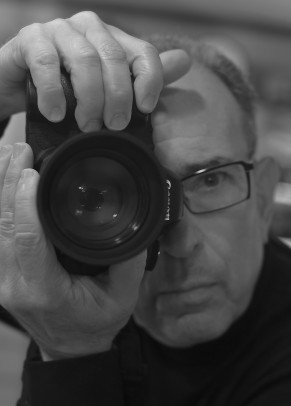Surgery and photography not so different, physician says

Photos of the Peruvian Amazon river people taken by urologist Larry Ross are featured in an exhibit at Instituto Cervantes Chicago, through Dec. 2.
Long-time urologist Larry Ross says his surgical skills make him a better photographer.
“As a surgeon, I am a visual person,” he said. “As an artist, I use my visual skills to create photographic images of people and their communities.”
Pursuing photography has meant learning new ways of talking with people, said Ross, emeritus professor of urology.
“As a physician it’s pretty easy,” he said. “Your patients need you, and they open up to you. I find that as a photographer, I’m a little reticent to approach people. I have to convince them that, one, I’m not dangerous, and two, I’m interested in them.”
Ross’s interest in the Ribereńos — the river people of the Peruvian Amazon — led to his photo exhibit at Instituto Cervantes Chicago, 31 W. Ohio. The exhibit will be displayed through Dec. 2.
Opening night, Nov. 3, attracted more than 150 viewers, including the consul general of Peru.
A longtime patient, federal judge Marvin Aspen, couldn’t make it, so Ross gave him a tour a few days later and we tagged along.
Ross pointed to his photo of a sprawling raft floating downstream on the Amazon, piled with items to sell at market.
The family will sell not only the goods but the raft itself, which will be cut apart and used as building material. They will return to their home village aboard a powerboat.
Another photo shows a boy cutting sugar cane with a machete. Next to that image, another boy smiles broadly, his darkened teeth showing that he eats the cane.
“They don’t have mirrors,” Ross said. “Their only self-image is in the river.” To the children’s delight, he showed them images of their faces on the screen of his digital camera.

The exhibit includes photos Ross took of the Ribereńos — the river people of the Peruvian Amazon. “They don’t have mirrors,” Ross says. “Their only self-image is in the river.”
A little girl has a protruding abdomen. “They drink river water, and almost everybody gets a tapeworm,” Ross explained.
The next photo was of a grass-skirted shaman. He prepares a remedial plant to kill the tapeworm.
“When he found out I was a doctor, he wanted his picture taken with me, another doctor,” Ross said.
A piranha shows off its fearsome teeth in another image.
“The teeth aren’t meant to eat meat,” Ross noted. “The fish eat nuts and fruit that fall in the water, along with an injured animal or fish.”
A naturalist told him piranha got their reputation from a 1978 movie that showed the fish attacking a side of beef.
“That made Americans think they were man-eaters,” Ross said. But usually they are dangerous only to fishermen who are careless about taking them off the hook.
He fished for piranha and caught a few. “They’re actually pretty tasty,” he said. At the moment he dined, Ross was a man eating piranha.
Ross’s exhibit contains 29 photos. Many can be viewed at his new website, which also displays shots taken in Bhutan and Nepal on a recent trip. He also posts images on the National Geographic website “Your Shot.”
Medicine and art
Ross was born in Chicago and spent his youth there, except for three years in Cleveland during grammar school. He earned a bachelor’s degree and an MD, with honors, at the University of Chicago.
He was chair of urology at Michael Reese Medical Center from 1984 to 1989, when he joined UIC as head of urology. He served in the department for 26 years and the Dr. Lawrence S. Ross Professorship was established in his honor.
Ross has been president of the American Urological Association, the Chicago Urological Society and Illinois State Urological Society.
He lives in Lincolnwood with his wife, Marcia, former associate Midwest director for the U.S. Holocaust Memorial Museum in Washington, D.C.
They have two daughters, Hope, in web-based digital marketing and a certified life coach, and Heather, an attorney specializing in couples with infertility issues.
His artistic talent may be inherited, he said. His mother was a painter, as is his sister. As a teenager he attended classes at the School of the Art Institute.
“My father was always interesting in taking pictures. He gave me an old folding Kodak — it was my first camera,” Ross said.
“And I migrated into photography.”
